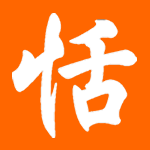Jon says:
Hi Tian - my personal trainer showed me his tat today. He thinks it says "Kyan" which is his son's name. He said his Taiwanese-Okinawan friend wrote it for him. In Cantonese I think it says, "hei nguk mo" (happy house fight or brawl or something) and I'm guessing it would also be at least three syllables in Japanese, too. So I thought he was on crack. BUT when I put them into Google
喜屋武
I get 76,000 pages - mostly of a girl named Chiaki Kyan, who is a cosplay idol. I'm stumped as to where they're getting "Kyan," though. It's a mystery to this poor gwailo...
anyway, thought I'd share.


This is an somewhat obscure Japanese reading of the Kanji. 喜ゃ can be read as きゃ (kya). 屋 is commonly read as や (ya). 武 can be read as ん (n) in this case (have a look at http://www.csse.monash.edu.au/~jwb/cgi-bin/wwwjdic.cgi?1MKJ%C9%F0)
ReplyDeleteTo me, the somewhat mysterious thing is the little ゃ being dropped and 屋 taking it's place without changing the reading.
"喜屋武" is an Okinawan surname, apparently.
ReplyDeleteThe only result for "Kyan" in the EDICT that uses kanji happens to be 喜屋武. He probably just used a dictionary.
ReplyDeleteAs for how three characters make the one-syllable "Kyan"... it's sort of a stretch, but it does work. The 喜 first kanji's on'yomi is き as in 喜悦【きえつ】 joy, the 屋 second's kun'yomi is や as in 部屋【へや】 room, and the 武 third has ん as a nanori. Put 'em together and you get きやん → きゃん!
The Japanese have a thing about coming up with extremely bizarre ways of writing names in kanji. Using normal readings is considered uncool. It's sort of like the old joke about "ghoti" being an alternate spelling for "fish" ("gh" as in "enough", "o" as in "women", "ti" as in "nation"). The Japanese do that kind of thing routinely when it comes to proper names.
ReplyDeleteAnd apparently it confuses even them.
I don't really even see this as all that unusual, honestly. I've seen 武 pronounced ん before (though I forgot just where), and ん itself comes from 无, which is also pronounced "mu" or "bu."
ReplyDeleteAteji, such as 秋刀魚 (pronounced "sanma"), are much stranger, since the kanji strictly represent meaning, and not pronunciation.
Japanese language has a whole set of characters to be used in proper names, named jinmeiyou kanji (人名用漢字) what is more, the regular kanji list has special readings to be used just for names. There are zillion ways to write Hiroshi or Kaori for instance. A real pain in the rear for translators that have to work with documents with lots of namesç A Japanese friend of mine told me that he had a friend named Ninomae Hajime (in Japanese order) which is written like: 一一 . Ninomae (surname) means: before two, which means one (一) and Hajime is a popular name given to first children, which means beginning and commonly written with 一
ReplyDeleteYes, apparently there is also an article on Chotoku Kyan on Wikipedia who also has this family surname Kyan.
ReplyDeletehttp://en.wikipedia.org/wiki/Ch%C5%8Dtoku_Kyan
I might hazard a guess that it's pronounced in Okinawan?
If the guy lives in Hong Kong why didn't he get a local Cantonese speaker to transliterate his son's name instead of someone from some little island in the middle of nowhere?
ReplyDeleteStrangely enough, the reading きゃん (kyan) for 喜屋武 is obscure but legit. Which means if you ask Japanese, they would try to read it ki-aku-mu, but if you explain to them it's supposed to be "kyan" they'd say "un, naru hodo".
ReplyDeleteWhat I'm not sure about is, whether it is a proper Japanese surname. Japanese gravure idols tend to have names which are the Japanese equivalent of "Linda Lovelace" or "Felicity Shagwell". So it could be that Mrs. Kyan invented the name 喜屋武 when she decided to get breast surgery and do bikini shots.
All in all, it's not a complete failure, but just spelling "Kyan" in the latin alphabet would have been easier and look better. The calligraphy on the tattoo is awful.